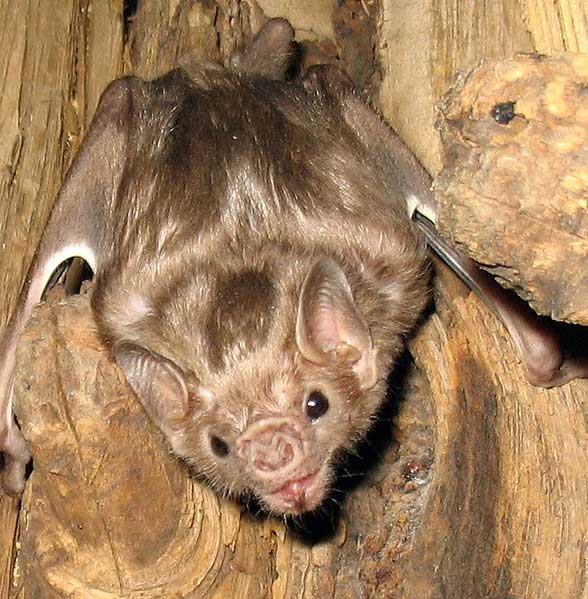
Diaemus youngi (*)
Cladus: Eukaryota
Supergroup: Opisthokonta
Regnum: Animalia
Subregnum: Eumetazoa
Cladus: Bilateria
Cladus: Nephrozoa
Cladus: Deuterostomia
Phylum: Chordata
Subphylum: Vertebrata
Infraphylum: Gnathostomata
Superclassis: Tetrapoda
Classis: Mammalia
Subclassis: Theria
Infraclassis: Eutheria
Ordo: Chiroptera
Subordo: Microchiroptera
Superfamilia: Noctilionoidea
Familia: Phyllostomidae
Subfamilia: Desmodontinae
Genus: Diaemus
Species: Diaemus youngi
Name
Diaemus youngi Jentink, 1893
Type locality: Guyana, Berbice River.
Synonyms
* cypselinus Thomas, 1928
References
* Jentink. 1893. Notes Leyden Museum, 15: 282.
* Conservation status: IUCN link: Diaemus youngi (Least Concern)
Distribution
* Tamaulipas (Mexico) south to N Argentina, Bolivia, Paraguay, and East Brazil
* Trinidad
* Margarita Island (Venezuela)
Vernacular names
English: White-winged Vampire Bat.
The White-winged Vampire Bat (Diaemus youngi) is a species of vampire bat. It is the only member of the genus Diaemus. It is found from Mexico to southern Argentina and is present on the islands of Trinidad and Isla Margarita. In Trinidad up to 30 Diaemus were found in a hollow immortelle tree and one was found in a well-lit cave along with Desmodus rotundus and Saccopteryx bilineata. Flying individuals are easily identified by their white wing tips.[1]
They seem to prefer the blood of birds to that of mammals and usually feed by hanging on the underside of a branch. Not surprisingly, they do not perform the flight-initiating jumps that characterize the common vampire bat, Desmodus rotundus. And although not as agile on the ground as the common vampire bat, they are quite proficient at climbing branches. White-winged vampires are much more docile than common vampire bats and are also extremely vocal in the audible range.
They have two large oral glands:
". . . which can only be seen when the bat's mouth is opened and the glands brought forward like two small cannons. With open mouth, the bat will suddenly make an explosive, hissing sound followed by a foul smelling odour which seems to come from these glands. The use of the glands is not known." [2]
"The bat opens its mouth when disturbed, bringing to the corners of its mouth two cup-shaped glands, each 2 to 3 mm in diameter, nearly filling the mouth. When necessary the glands can be directed forward, and with a noisy "psst" may emit a fine jet of liquid which has a powerful mustelid, skunk-like odor offensive to many people. Extractions tests made in Trinidad indicated the presence of several common amino acids and an unidentified sulphur-containing compound."[3]
This bat has been found to carry rabies in Trinidad.[4]
Footnotes
1. ^ A.M. Greenhall and U. Schmidt, editors. 1988. Natural History of Vampire Bats, CRC Press, Boca Raton, Florida. ISBN 0849367506; ISBN 978-0849367502, p. 122
2. ^ Greenhall, Arthur M. 1961. Bats in Agriculture. A Ministry of Agriculture Publication. Trinidad and Tobago, p. 10.
3. ^ A.M. Greenhall and U. Schmidt, editors. 1988. Natural History of Vampire Bats, CRC Press, Boca Raton, Florida. ISBN 0849367506; ISBN 978-0849367502, p. 125.
4. ^ Greenhall (1961), p. 10.
References
* Carter G, B Fenton, P Faure. 2009. "White-winged vampire bats exchange contact calls." Canadian Journal of Zoology. 87, 604-608. doi: 10.1139/Z09-051. PDF
* Carter G, M Skowronski, P Faure, B Fenton. 2008. "Antiphonal calling allows individual discrimination in white-winged vampire bats." Animal Behaviour. 76, 1343-1355 doi:10.1016/j.anbehav.2008.04.023. PDF
* Greenhall, Arthur M. 1961. Bats in Agriculture. A Ministry of Agriculture Publication. Trinidad and Tobago.
* A.M. Greenhall and U. Schmidt, editors. 1988. Natural History of Vampire Bats, CRC Press, Boca Raton, Florida. ISBN 0849367506; ISBN 978-0849367502
* Barquez, R., Perez, S., Miller, B. & Diaz, M. (2008) Diaemus youngi In: IUCN 2010. IUCN Red List of Threatened Species. Version 2010.2. www.iucnredlist.org Retrieved on 17 July 2010.
* Mammalian Species Account
Retrieved from "http://en.wikipedia.org/"
All text is available under the terms of the GNU Free Documentation License

